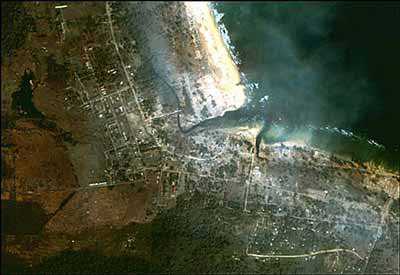 An inlet of India's Little Andaman Island, located in the eastern Indian Ocean, shows damage caused by the December 26, 2004, tsunami in this satellite image. (Image courtesy NASA.)
An inlet of India's Little Andaman Island, located in the eastern Indian Ocean, shows damage caused by the December 26, 2004, tsunami in this satellite image. (Image courtesy NASA.)
Host Steve Curwood talks with Sophie Grig of Survival International, a worldwide organization supporting tribal peoples. She's been tracking information on the effect of the tsunami on the isolated tribes of the Andaman and Nicobar Islands. Some of these tribes are hunter-gatherers who came to the islands from Africa 60,000 years ago. It's believed that many tribal members of the Andamans survived the tsunami, while the Nicobar Island tribes may not have fared as well.
CURWOOD: From the Jennifer and Ted Stanley Studios in Somerville, Massachusetts, this is Living on Earth. I’m Steve Curwood.
As aid and recovery teams labor in the wake of the Indian Ocean earthquake and tsunami, thousands of people are still listed as missing. At first there were concerns that some tribes that go back more than 60,000 years had been swept away. But now it appears that some - though certainly not all - of these tribes on islands that include the Andaman and Nicobar in the Bay of Bengal may have fared reasonably well, considering.
These tribes include the Sentinelese, the Onge, the Jawara and the Great Andamanese. Many have fiercely protected their hunter-gatherer lifestyles despite attempts at colonization.
Sophie Grig is a campaigner for Survival International, an organization supporting tribal peoples. Sophie, is it possible that the cultural practices of these tribes who survived helped protect them from the tsunami?
GRIG: It’s difficult to know because actually incredibly little is known about the tribes on the Andaman Islands. Some of the tribes we know absolutely nothing about. The Sentinelese, nobody can speak a word or their language. We don’t even know what they call themselves – it certainly isn’t Sentinelese. They will have a very close relationship with the nature, they live by hunting and gathering, they fish in the sea with bows and arrows.
 An inlet of India's Little Andaman Island, located in the eastern Indian Ocean, shows damage caused by the December 26, 2004, tsunami in this satellite image. (Image courtesy NASA.)
An inlet of India's Little Andaman Island, located in the eastern Indian Ocean, shows damage caused by the December 26, 2004, tsunami in this satellite image. (Image courtesy NASA.)
They’ve been there for 60,000 years. We understand that probably about every 10,000 years there’s been an earthquake or a tsunami or something that’s affected the area by looking at the geography of it. And so, we understand that probably they’ve had a lot of experience with this in their people’s history, and so probably they do have mechanisms and an understanding, much more than the more recent settlers who wouldn’t have known what to do.
CURWOOD: How did the topography of these islands protect some of these tribes from the worst effects of the tsunami?
GRIG: Well, the areas where the tribal people tend to be are the areas where, actually, there’s been the least ecological damage. And I understand that coral reefs and mangrove swamps are actually very good at dissipating the power of a tsunami. And where the tribal people are is the area where the forests haven’t been damaged, and where the mangrove swamps haven’t been damaged, and where the coral reefs are most intact. So it’s quite possible that by defending their land from the aggression of the outsiders, and from the cultivation and destruction that much of the islands have suffered from, the tribal peoples themselves, actually, that also added to help them in the wake of the tsunami.
CURWOOD: Now, help me in another area. This is not your expertise, but we’ve seen a number of news wire stories that have suggested that many animals survived the tsunami because they had some sort of a sixth sense that an earthquake was coming, and maybe they knew intuitively to head to higher ground. What of those stories do you link to what happened with these aboriginal people?
GRIG: Well, I think it’s quite likely. I mean, the tribal people who live in the forest, they live from hunting the animals. They have an extremely intimate relationship with the animals and an extremely good understanding of what the animals are doing and what they’re thinking, and that’s how they can successfully hunt and live in the forest. And so they may well have watched the animals and seen what the animals were doing and followed their lead. Or maybe they also just have a very, such a close relationship with the land, that they understand what’s happening, too.